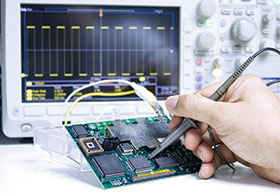

The faster and more complex electronic circuits become, the greater the performance requirements are for the equipment with which to test and verify their performance. At the same time, the smartphone revolution has elevated users’ expectations in terms of ease of use and versatility. We asked Jason Strydom, account manager at Comtest, to elaborate on some of the ways in which oscilloscope technologies are advancing to keep pace with these demands.
What are some of the latest features in user interfaces?
The user interface is one of the biggest changes more recently, with a move towards larger touchscreens and USB-based devices. Larger touchscreens are now coming in high definition with true design for touch. This improves the sensitivity of the touchscreen and allows the user to more accurately control what they need to on it.
There is also a trend with light-up buttons on the device which change colour depending on which channel is selected. This ensures that the user knows which channel he is taking his measurement on or adjusting the settings for.
USB-based oscilloscopes, on the other hand, are bringing this functionality at a lower cost as they are able to interface to an already existing PC with a monitor for greater control compared to the previous instruments in the industry.
These options now make using these devices more ergonomic and allow the user to reference and control the instrument more easily so they can get their desired measurements faster, and save time during the design and development cycle.
What must engineers consider with regards to data interfaces?
Interfaces are all about what you want to do with the data or instrument. USB connection has become a great way to get your data locally and fast; this is useful if you want to use RF software on a PC coupled to the oscilloscope.
Alternatively, if users require remote connection then an IP connection can be very useful for controlling the instrument over a network (e.g. someone in their office being able to control an instrument that is in the lab). Additionally, for a Windows-based device, a video output port could be considered to incorporate multitasking on the device.
GPIB, among other interfaces, can be used to incorporate the device into an automated test system. PXI is an open standard that only a few vendors support, and is typically used where users need to incorporate multiple different types of high-speed instruments (not just an oscilloscope) into a particular system.
How are bandwidth and channel counts keeping pace?
We are seeing bandwidth upgrades and higher channel counts on mid-range instruments, indicating the mid-range is shifting upwards. We now have options for up to 8 channels on a single device, something that hasn’t been common until recently.
We also have the ability to synchronise multiple instruments, should the user need more than 8 high-speed measurement channels. Additionally, there are options to upgrade the standard bandwidth on many devices, even after the device has been acquired by an end user.
What other features are engineers looking for?
There are a few standard criteria that users should always be on the lookout for, such as bandwidth at least 5 times faster than signal speed, sample rate at least 5 times faster than your signal, and enough input channels
It is also important to consider having compatible probes of the right type (passive probes, active probes, current probes, near-field probes for RF, or even high-speed probes with a solder connection onto the board to be tested). Accessories (transit cases, software for in-depth analysis, adaptors, preamplifiers or even interposers), easy operation, connectivity, serial bus decoding, and in-country support are also important factors.
Additional features that users should be looking for are integration of time and frequency domain (RF) analysis on a single device, visual triggering, power measurements, built-in demonstration files so the user can see how to easily set up their acquisition, and the ability to mount network drives on non-Windows oscilloscopes.
For more information contact Jason Strydom, Comtest, +27 10 595 1821, [email protected], www.comtest.co.za
| Tel: | +27 10 595 1821 |
| Fax: | +27 11 608 1525 |
| Email: | [email protected] |
| www: | www.comtest.co.za |
| Articles: | More information and articles about Comtest |
© Technews Publishing (Pty) Ltd | All Rights Reserved